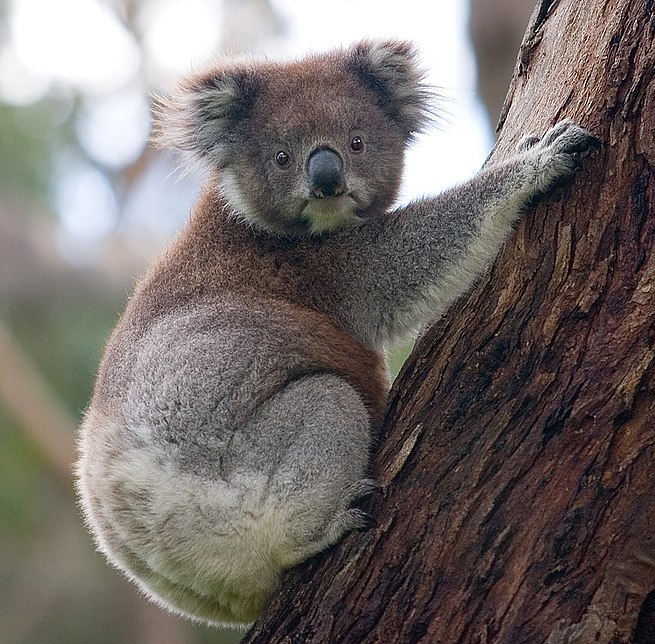Main Difference
The main difference between Koala and Panda is that the Koala is a marsupial and Panda is a species of mammal
-
Koala
The koala (Phascolarctos cinereus, or, inaccurately, koala bear) is an arboreal herbivorous marsupial native to Australia. It is the only extant representative of the family Phascolarctidae and its closest living relatives are the wombats. The koala is found in coastal areas of the mainland’s eastern and southern regions, inhabiting Queensland, New South Wales, Victoria, and South Australia. It is easily recognisable by its stout, tailless body and large head with round, fluffy ears and large, spoon-shaped nose. The koala has a body length of 60–85 cm (24–33 in) and weighs 4–15 kg (9–33 lb). Pelage colour ranges from silver grey to chocolate brown. Koalas from the northern populations are typically smaller and lighter in colour than their counterparts further south. These populations possibly are separate subspecies, but this is disputed.
Koalas typically inhabit open eucalypt woodlands, and the leaves of these trees make up most of their diet. Because this eucalypt diet has limited nutritional and caloric content, koalas are largely sedentary and sleep up to 20 hours a day. They are asocial animals, and bonding exists only between mothers and dependent offspring. Adult males communicate with loud bellows that intimidate rivals and attract mates. Males mark their presence with secretions from scent glands located on their chests. Being marsupials, koalas give birth to underdeveloped young that crawl into their mothers’ pouches, where they stay for the first six to seven months of their lives. These young koalas, known as joeys, are fully weaned around a year old. Koalas have few natural predators and parasites, but are threatened by various pathogens, such as Chlamydiaceae bacteria and the koala retrovirus, as well as by bushfires and droughts.
Koalas were hunted by indigenous Australians and depicted in myths and cave art for millennia. The first recorded encounter between a European and a koala was in 1798, and an image of the animal was published in 1810 by naturalist George Perry. Botanist Robert Brown wrote the first detailed scientific description of the koala in 1814, although his work remained unpublished for 180 years. Popular artist John Gould illustrated and described the koala, introducing the species to the general British public. Further details about the animal’s biology were revealed in the 19th century by several English scientists. Because of its distinctive appearance, the koala is recognised worldwide as a symbol of Australia. Koalas are listed as Vulnerable by the International Union for Conservation of Nature. The Australian government similarly lists specific populations in Queensland and New South Wales as Vulnerable. The animal was hunted heavily in the early 20th century for its fur, and large-scale cullings in Queensland resulted in a public outcry that initiated a movement to protect the species. Sanctuaries were established, and translocation efforts moved to new regions koalas whose habitat had become fragmented or reduced. The biggest threat to their existence is habitat destruction caused by agriculture and urbanisation.
-
Panda
The giant panda (Ailuropoda melanoleuca, literally “black and white cat-foot”; Chinese: 大熊猫; pinyin: dà xióng māo, literally “big bear cat”), also known as panda bear or simply panda, is a bear native to south central China. It is easily recognized by the large, distinctive black patches around its eyes, over the ears, and across its round body. The name “giant panda” is sometimes used to distinguish it from the unrelated red panda. Though it belongs to the order Carnivora, the giant panda’s diet is over 99% bamboo. Giant pandas in the wild will occasionally eat other grasses, wild tubers, or even meat in the form of birds, rodents, or carrion. In captivity, they may receive honey, eggs, fish, yams, shrub leaves, oranges, or bananas along with specially prepared food.The giant panda lives in a few mountain ranges in central China, mainly in Sichuan, but also in neighbouring Shaanxi and Gansu. As a result of farming, deforestation, and other development, the giant panda has been driven out of the lowland areas where it once lived.
The giant panda is a conservation reliant vulnerable species. A 2007 report showed 239 pandas living in captivity inside China and another 27 outside the country. As of December 2014, 49 giant pandas lived in captivity outside China, living in 18 zoos in 13 different countries. Wild population estimates vary; one estimate shows that there are about 1,590 individuals living in the wild, while a 2006 study via DNA analysis estimated that this figure could be as high as 2,000 to 3,000. Some reports also show that the number of giant pandas in the wild is on the rise. In March 2015, Mongabay stated that the wild giant panda population had increased by 268, or 16.8%, to 1,864. In 2016, the IUCN reclassified the species from “endangered” to “vulnerable”.While the dragon has often served as China’s national symbol, internationally the giant panda appears at least as commonly. As such, it is becoming widely used within China in international contexts, for example since 1982 issuing gold panda bullion coins or as one of the five Fuwa mascots of the Beijing Olympics.
-
Koala (noun)
A tree-dwelling marsupial, Phascolarctos cinereus, that resembles a small bear with a broad head, large ears and sharp claws, mainly found in eastern Australia.
-
Panda (noun)
The red panda, a small raccoon-like animal, Ailurus fulgens of northeast Asia with reddish fur and a long, ringed tail. from 19th c.
“lesser panda|red panda”
-
Panda (noun)
The giant panda – a black and white bear-like animal, Ailuropoda melanoleuca from the mountains of China. from 19th c.
“mottled bear|panda bear”
-
Panda (noun)
A police car. from 20th c.
-
Panda (noun)
A brahmin who acts as the superintendent of a particular ghat or temple, as a hereditary position. from 20th c.

